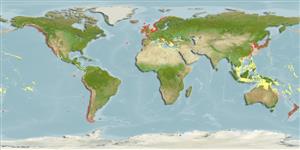Common names from other countries
Classification / Names / Names
Namen | Synonyme | Catalog of Fishes (gen., sp.) | ITIS | CoL | WoRMS
Environment: milieu / climate zone / depth range / distribution range
Ökologie
. Subtropical
Western Pacific.
Length at first maturity / Size / Gewicht / Alter
Maturity: Lm ? range ? - ? cm Max length : 3.0 cm H Männchen/unbestimmt; (Ref. )
Relatively small with tentacular crown up to 3.5 centimeters in diameter and 3 cm in height. Smooth green-gray or brown cylindrical column that may or may not have vertical orange or white stripes. 50 to 100 slender, tapering tentacles that are fully retractile, usually transparent, sometimes gray or light green flecked with white.
Life cycle and mating behavior
Geschlechtsreife | Fortpflanzung | Ablaichen | Eier | Fecundity | Larven
Capable of both asexual reproduction, through longitudinal fission, and sexual reproduction through release of gametes by both sexes followed by external fertilization and embryonic development (Ref. 3248).
Cairns, S.D., D.R. Calder, A. Brinckmann-Voss, C.B. Castro, D.G. Fautin, P.R. Pugh, C.E. Mills, W.C. Jaap, M.N. Arai, S.H.D. Haddock and D.M. Opresko. 2003. (Ref. 1663)
IUCN Rote Liste Status (Ref. 130435: Version 2024-1)
CITES Status (Ref. 108899)
Not Evaluated
Not Evaluated
Bedrohung für Menschen
Harmless
Nutzung durch Menschen
| FishSource |
Tools
Mehr Information
Alter/GrößeWachstumLänge-GewichtLänge-LängeMorphologieLarvenDichte
Internet Quellen
Estimates based on models
Preferred temperature
(Ref.
115969): 8 - 21.9, mean 12.1 (based on 886 cells).
Verwundbarkeit
Low vulnerability (10 of 100).
Preiskategorie
Unknown.
